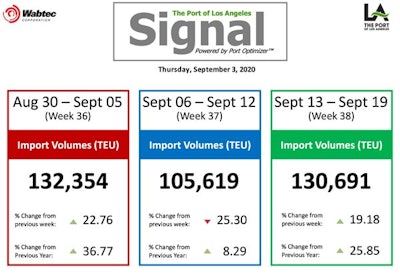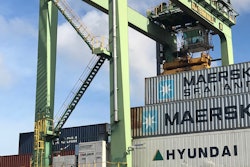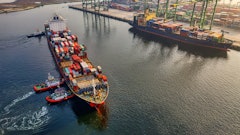
The Port of Los Angeles will begin distributing and publishing key dashboard data from Wabtec’s Port Optimizer so that all supply chain stakeholders have easy access and can use the forward-looking information to better plan and prepare for inbound cargo.
“We’re giving all of our partners — railroads, chassis providers, truckers, warehouse operators and others in the supply chain — a three-week look at cargo coming into Los Angeles,” said Gene Seroka, Executive Director of the Port of Los Angeles. “This planning tool will help make our partners more nimble and efficient, especially during volume surges like we are currently experiencing. This is the forward visibility our stakeholders have requested and we are proud to deliver it.”
Unveiled at today’s Los Angeles Harbor Commission meeting, “The Port of Los Angeles Signal” is a service of the Port of Los Angeles and powered by the Port Optimizer. It includes a dashboard view of how many shipments will be arriving in Los Angeles over the next three weeks. The data is broken down by container type and includes details on the mode of transportation, whether rail or truck, once it arrives in Los Angeles.
“The Signal” will be updated weekly on the Port’s website, portoflosangeles.org, shared on the @PortofLA Twitter account and Port of Los Angeles LinkedIn page. It will also be emailed directly to stakeholders.
No proprietary information will be shared.
Stakeholders looking for more detailed data can also utilize the Port Optimizer import data page, http://volumes.portoptimizer.com, which is updated every weekday. The Port Optimizer can be found at https://track.portoptimizer.com
“We want stakeholders to have every advantage possible to better utilize their assets and plan for labor,” said Kareen Gray, Vice President Sales, Transport Logistics, for Wabtec. “This data can help facilitate better cargo tracking, projections and productivity.”
“We applaud the Port of Los Angeles for their continued efforts to bring visibility and transparency to the supply-chain,” said Weston LaBar, CEO of the Harbor Trucking Association (HTA). “The HTA has been a vocal advocate for using data as an advanced planning and forecasting tool. These efforts will help further that cause by providing advanced notification and visibility through the Port Optimizer, which will help facilitate much needed efficiencies we all desire.”




















